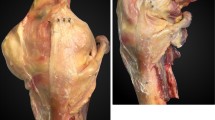Abstract
Background. The biomechanical changes in the cruciate ligament-deficient knee are still widely unexplained. By producing a model of cruciate ligament insufficiency in the knee joint, we wanted to provide an experimental explanation for the great amount of secondary injuries to the knee joint after conservative treatment of an anterior cruciate ligament rupture.
Methods. The forces exerted on the medial and lateral collateral ligament were measured in ten fresh human cadaver knees. While simulating muscle force and body weight, the ligamentous loading patterns were determined before and after the anterior cruciate ligament was transected. The specimens were moved in a special apparatus from 0° extension to 100° flexion. Strain gauges were used to measure the ligament forces. They were fixed at the bony origins and insertions of the examined ligaments. The method allowed all ligamentous and capsular structures to be kept intact, thereby creating nearly physiological conditions by simulating muscular strength and axial force.
Results. During the quasistatic measurements, the relative changes of the ligament forces were determined from one angle position to the next. The variability of these relative values were very small among the ten specimens. The method yielded reproducible ligament force data. The values obtained in the intact knee joints were markedly similar to those reported in the literature. Cutting the anterior cruciate ligament led to a general increase of the ligament forces on both collateral ligaments.
Conclusion. Our results show excess stress of the main ligamentous stabilisers after anterior cruciate ligament transection. This is an explanation for the secondary injuries often seen after conservative treatment of anterior cruciate ligament rupture as a result of impaired knee biomechanics.
Similar content being viewed by others
Author information
Authors and Affiliations
Additional information
Electronic Publication
Rights and permissions
About this article
Cite this article
Hinterwimmer, .S., Baumgart, .R. & Plitz, .W. Tension changes in the collateral ligaments of a cruciate ligament-deficient knee joint: an experimental biomechanical study. Arch Orthop Trauma Surg 122, 454–458 (2002). https://doi.org/10.1007/s00402-002-0432-5
Received:
Issue Date:
DOI: https://doi.org/10.1007/s00402-002-0432-5




